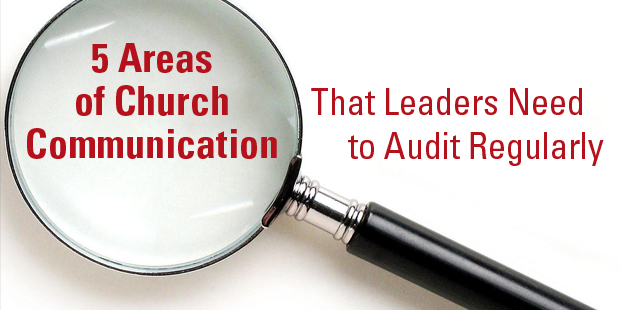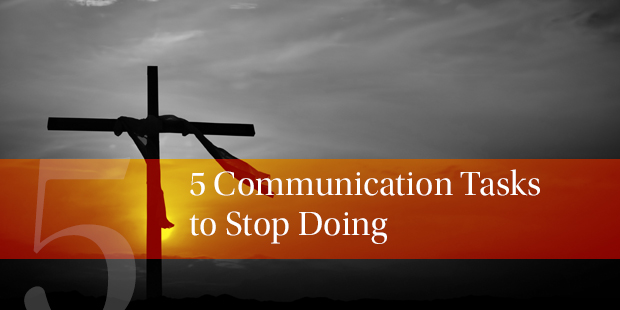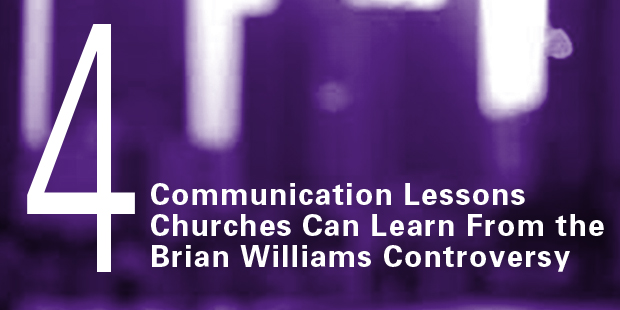Everything your church does is communication, from the condition of the parking lot to the content in your bulletin to the tone of your sermon. Everything you do communicates something about what you really value, regardless of what you say you value.
I’m a church communications nut. I read dozens of blogs on design, branding, social media and marketing. I’ve designed logos, websites, and print pieces for dozens of churches. So I’ve perfected the art and science of church communications, right? Actually, in the last week, I received an email from someone who couldn’t find a location for our services, another who had a hard time finding out how to get involved, and a third who couldn’t find details on a couple of upcoming events. #humbled
But our bulletin does look kind of pretty…
Since the publishing and communication of the gospel is paramount, I’ve learned the value of doing some punch-me-in-the-gut audits of our communication strategy. We’re constantly tweaking and improving so that we can put our best foot forward and do the best possible job of getting the word out, connecting people to each other, plugging people in, and staying in touch.
To every Lead Pastor I would say, you need to perform an audit of your church’s communication strategy to see if all those sermons you’re studying so hard for will have maximum reach in your community. Here’s a questionnaire, divided by areas of communication.
BRANDING
Phil Cooke defines a brand as “the story people tell about a person, product, or organization.” Yourchurch has a brand in your community whether you realize it or not. The key to understanding your brand is to find out what story people tell when your church gets brought up in conversation. That’s your brand.
- What story do we want people to associate with our church? How would we like people to feel when they think about us?
- What story do people actually tell about us? And how do we know this?
- Does the appearance of our building, landscaping, and outdoor signage communicate the feelings we want people to experience?
- Do we have a church logo that communicates the feeling and the story we want people to experience?
- Does our website, bulletin, and other printed materials such as brochures, business/invite cards, or postcards uniformly agree with the story we’re telling across the board?
CHURCH WEBSITE
If you’re not found in a Google search for churches in your area, you don’t exist to people moving into town. A website is essential, even if it’s a free or inexpensively made website. And while not every church can afford the fees charged by professional designers, we still ought to invest in our website with both energy and resources that honor the importance of this crucial area of communication.
- Is our website responsive and mobile-friendly?
- Is our most basic information easy to find on our main homepage (location, service times, etc.)?
- Do we use imagery that tells people that we’re human, we’re alive, and we’re welcoming?
- Are event listings available and up-to-date?
- Can people easily know what we believe? what we value? and how we function?
- Do we have links to our Facebook page and other social profiles on our website?
- Is there a way for people to reach out and get in touch with us without leaving our website?
- Can people easily know how to pursue next steps such as baptism, joining a small group, or volunteering in an area of ministry?
- Do we have a page dedicated to our staff and/or key leaders so that potential visitors can know who we are?
SOCIAL MEDIA
Social media is a weird phrase. Media is just information, and “social” simply refers to how information spreads – from person to person, socially. When we use the phrase “social media” we’re generally referring to the websites or web-based platforms used for social networking. While a previous generation got to know social media as an optional activity, an up-and-coming generation sees social media the way we see oxygen – it’s just part of the air people are breathing.
- Do we have a main church Facebook page?
- Do the header and profile images represent us well? Are they consistent with the branding on our website and print pieces?
- Are we a location that people can check into when they visit on Sunday?
- Is our address, phone number, and website address displayed in the ‘about’ area?
- Are we posting regularly? At least weekly if not several times per week?
- Are we posting a variety of content such as pictures, text, and links?
- Are we offering more than just announcements? Are we also telling stories, giving valuable content, and extending the preaching of our church in a positive way?
- Do we engage our fans and followers by responding to comments?
- Are our key leaders using social media? Are they on Facebook and Twitter? And do they promote the ministry of the church through those platforms?
PRINT DESIGN
Many experts claim that “print is dying” but most people walking through the doors of a church building on Sunday still expect some kind of bulletin to know what’s going on.
- Does our bulletin look nice and clean? Does it match the look of our website and other communication mediums?
- Have we put guests first, using bulletin space to explain what to expect during their visit?
- Have we made it clear what announcements are really the most important?
- Do we use valuable space to communicate church-wide what could be communicated via a different means to only a few people?
- Have we offered clear “next steps” such as were to go online to get more information, how to sign up for events, and who to talk to about knowing Jesus, baptism, or church membership?
- Are we using readable typefaces?
COMMUNICATION SYSTEMS
A lot of work goes into planning special events and ministries. It’s a shame for that work to go to waste when the right people don’t know about the event or service we’re working toward. Systems are imperative if we’re going to communicate effectively.
- Do we have a process to follow when an event is planned?
- Do we have a calendar that can be seen and shared by all leaders to avoid scheduling conflicts?
- Do we have a checklist to glance at to be sure we’ve communicated events using every necessary means?
- Have we made it clear that only major, church-wide announcements need to be communicated from the stage or pulpit?
- Do we have any kind of content calendar or plan for what updates get posted on our website and social profiles and what times they should be posted?
There is more. Much more, in fact. But these 33 questions offer a great starting place for the leadership team of any small to medium-sized church. Knowing where we are and how we’re doing is half the battle!
> Read more from Brandon.

Tags: Brandon Cox, Communications Audit, church communications
|
What is MyVisionRoom? > | Back to Communication >





















